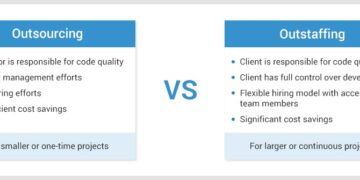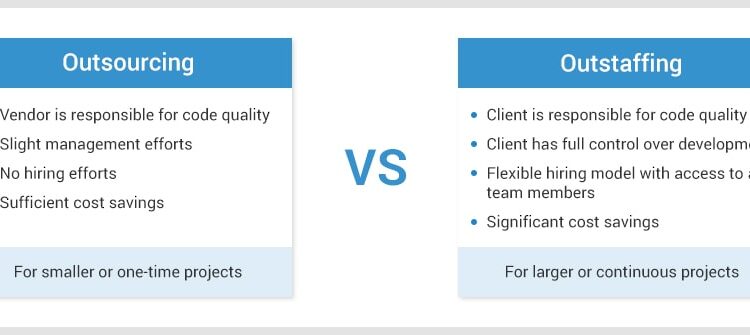In today’s dynamic business landscape, companies often seek innovative ways to optimize their operations and stay competitive. Two popular strategies that have gained prominence in recent years are outstaffing and outsourcing. While both involve delegating tasks to external entities, they differ significantly in their approach and implications for businesses. In this article, we will delve into the distinctions between outstaffing and outsourcing, exploring the benefits, challenges, and scenarios in which each strategy is most suitable.
Outstaffing Defined:
Outstaffing, also known as staff augmentation, is a business model where a company hires external professionals to work on specific projects or tasks. Unlike traditional outsourcing, the outstaffing model allows the client to have direct control and management of the external team. The outstaffed professionals become an extension of the client’s in-house team, working under their guidance and following their established processes.
Benefits of Outstaffing:
- Direct Control: One of the primary advantages of outstaffing is the direct control that clients maintain over the external team. This enables seamless integration into existing workflows and facilitates better communication.
- Customization: Outstaffing allows for a high level of customization. Clients can handpick professionals with the specific skills and expertise required for their projects, ensuring a tailored approach to their needs.
- Cost Efficiency: While outstaffing may not always be the cheapest option, it can be more cost-effective than maintaining a full in-house team. Companies can scale their workforce up or down based on project requirements, avoiding the expenses associated with permanent staff.
Challenges of Outstaffing:
- Time Zone Differences: If the outstaffed team is located in a different time zone, coordinating work hours and communication can be challenging. This requires effective planning and the use of collaborative tools.
- Integration Challenges: Achieving seamless integration with an external team may require initial effort in terms of onboarding and alignment of processes. Companies need to invest in building strong communication channels to bridge any gaps.
Outsourcing Defined:
Outsourcing is the practice of contracting out specific business functions or processes to a third-party service provider. In outsourcing, the client relinquishes direct control over the tasks, allowing the external provider to handle them independently. This model is commonly used for non-core functions, such as IT support, customer service, or manufacturing.
Benefits of Outsourcing:
- Focus on Core Competencies: Outsourcing enables companies to concentrate on their core competencies by delegating non-core functions to specialists. This can lead to increased efficiency and improved overall business performance.
- Access to Global Talent Pool: Outsourcing provides access to a global talent pool, allowing companies to tap into specialized skills that may not be readily available in their local market. This can be particularly advantageous for complex projects.
- Cost Savings: Outsourcing often results in cost savings, especially when the external provider is located in regions with lower labor costs. This can contribute to increased profitability for the client.
Challenges of Outsourcing:
- Loss of Control: The primary drawback of outsourcing is the loss of direct control over the outsourced tasks. Clients may face challenges in managing and monitoring the external provider’s performance.
- Communication Barriers: Differences in language and communication styles can lead to misunderstandings and hinder effective collaboration. Clear communication channels and regular updates are essential to overcome this challenge.
Conclusion:
In conclusion, both outstaffing and outsourcing are viable strategies for businesses looking to optimize their operations. The choice between the two depends on the specific needs, preferences, and goals of the company. Outstaffing offers direct control and customization, making it suitable for projects that require a hands-on approach. On the other hand, outsourcing provides access to a broader talent pool and cost savings, making it a valuable option for non-core functions.
Ultimately, businesses should carefully assess their requirements and consider factors such as project complexity, budget constraints, and the level of control desired before deciding between outstaffing and outsourcing. By understanding the nuances of each model, companies can make informed decisions that align with their strategic objectives and contribute to long-term success in the competitive global market.












































